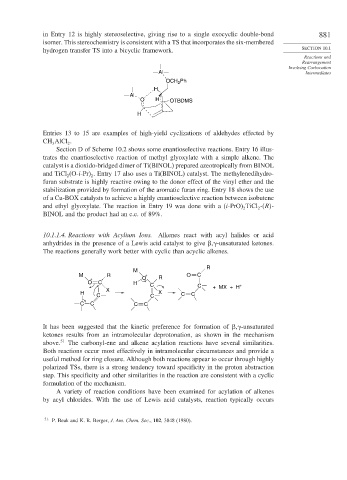Page 905 - Advanced Organic Chemistry Part B - Reactions & Synthesis
P. 905
in Entry 12 is highly stereoselective, giving rise to a single exocyclic double-bond 881
isomer. This stereochemistry is consistent with a TS that incorporates the six-membered
hydrogen transfer TS into a bicyclic framework. SECTION 10.1
Reactions and
Rearrangement
Involving Carbocation
Al Intermediates
OCH Ph
2
H
Al
O H OTBDMS
H
Entries 13 to 15 are examples of high-yield cyclizations of aldehydes effected by
CH AlCl .
3
2
Section D of Scheme 10.2 shows some enantioselective reactions. Entry 16 illus-
trates the enantioselective reaction of methyl glyoxylate with a simple alkene. The
catalyst is a dioxido-bridged dimer of Ti(BINOL) prepared azeotropically from BINOL
and TiCl (O-i-Pr) . Entry 17 also uses a Ti(BINOL) catalyst. The methylenedihydro-
2
2
furan substrate is highly reactive owing to the donor effect of the vinyl ether and the
stabilization provided by formation of the aromatic furan ring. Entry 18 shows the use
of a Cu-BOX catalysts to achieve a highly enantioselective reaction between isobutene
and ethyl glyoxylate. The reaction in Entry 19 was done with a (i-PrO) TiCl -(R -
2
2
BINOL and the product had an e.e. of 89%.
10.1.1.4. Reactions with Acylium Ions. Alkenes react with acyl halides or acid
anhydrides in the presence of a Lewis acid catalyst to give , -unsaturated ketones.
The reactions generally work better with cyclic than acyclic alkenes.
R
M
M R + O C
+ O R
O C H C C +
X + MX + H
H X C C
C C
C C C C
It has been suggested that the kinetic preference for formation of , -unsaturated
ketones results from an intramolecular deprotonation, as shown in the mechanism
above. 51 The carbonyl-ene and alkene acylation reactions have several similarities.
Both reactions occur most effectively in intramolecular circumstances and provide a
useful method for ring closure. Although both reactions appear to occur through highly
polarized TSs, there is a strong tendency toward specificity in the proton abstraction
step. This specificity and other similarities in the reaction are consistent with a cyclic
formulation of the mechanism.
A variety of reaction conditions have been examined for acylation of alkenes
by acyl chlorides. With the use of Lewis acid catalysts, reaction typically occurs
51
P. Beak and K. R. Berger, J. Am. Chem. Soc., 102, 3848 (1980).

